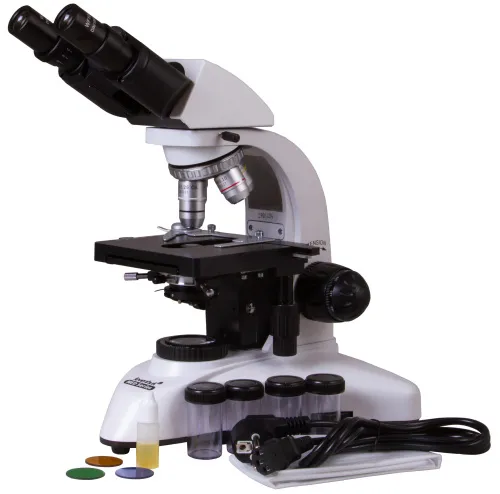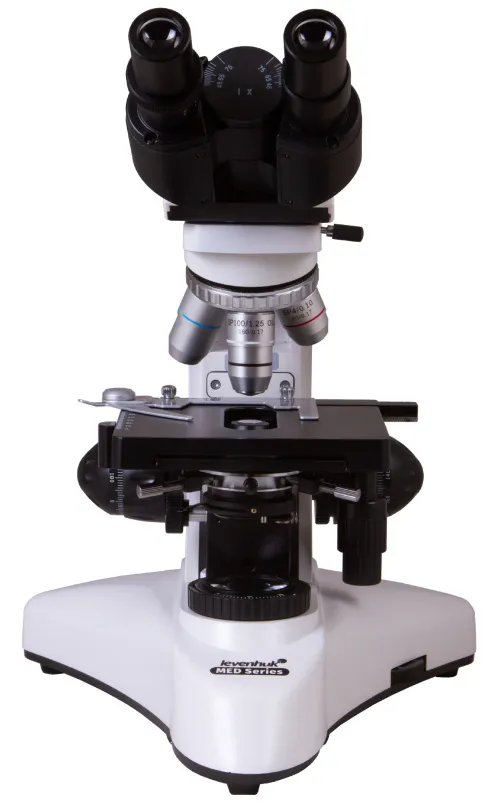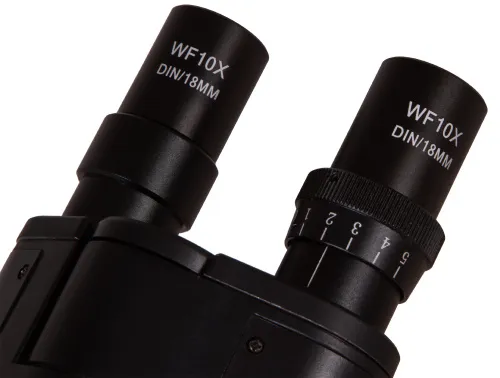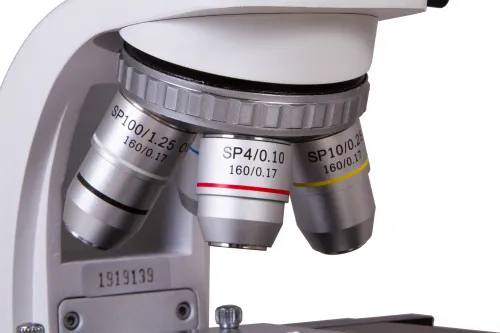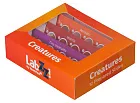Levenhuk MED 20B Binocular Microscope
Magnification: 40–1000x. Binocular head, semi-plan achromatic objective lenses, an Abbe condenser with an iris diaphragm, and a filter holder
| Product ID | 73988 |
| Brand | Levenhuk, Inc., USA |
| Warranty | lifetime |
| EAN | 5905555004907 |
| Package size (LxWxH) | 52x36x34 cm |
| Shipping Weight | 7.28 kg |
Levenhuk MED 20B Binocular Microscope is designed for professional research of the microcosm at magnifications of 40 to 1,000 times. It uses semi-plan achromatic optics that minimize chromatic aberrations and significantly flatten the curvature of the field of view. This microscope is an excellent acquisition for the microbiology department, medical laboratory, or research institute.
A binocular head is perfect for lengthy observations because you can look through the microscope with both eyes. The visual part features a 30° inclination angle. The trinocular head is 360° rotatable: this feature is useful for group research.
Wide-field eyepieces provide 10x magnification and allow for adjusting diopters in order to obtain an image that is as sharp as possible. The coarse and fine focusing allows for adjusting image sharpness. Both focusing systems have a low pitch and allow for setting up a microscope for complicated observations. A revolving nosepiece contains four objective lenses; 40x and 100x objectives are equipped with spring-loaded frames. A 100x objective can be used for observations using oil immersion (a bottle with immersion oil is included in the kit). The eyepieces and objective lenses are protected with a layer of anti-fungal coating.
A double-layer stage comes with a mechanical scale. The lighting system consists of a lower light source and Abbe condenser with an iris diaphragm and filter holder. A 20W halogen bulb is used as a light source. The light brightness is adjustable. The light is powered by an AC power supply. In addition, this microscope allows for setting up Köhler illumination.
Features:
- Binocular laboratory microscope
- Semi-plan achromatic optics, magnification of 40x to 1000x
- Anti-fungal coating of all the optical surfaces
- Halogen light powered by an AC power supply
- Köhler illumination is available
The kit includes:
- Microscope base with a stand
- 360° rotatable binocular head
- Semi-plan achromatic objective lenses 4x, 10x, 40xs, 100xs (oil) with an anti-fungal coating
- Wide-field eyepieces: WF10x/18mm with an anti-fungal coating (2 pcs)
- Abbe condenser N.A. 1.25 with an iris diaphragm and a filter holder
- Filters: blue, green, yellow
- Bottle of immersion oil
- Fuse (2 pcs)
- Power cord for microscope
- Dust cover
- User manual and lifetime warranty
Caution:
Please refer to the specifications table for the correct mains voltage and never attempt to plug a 110V device into 220V outlet and vice versa without using a converter. Remember that mains voltage in the U.S. and Canada is 110V and 220–240V in most European countries.
Some things you can see under a microscope:





Levenhuk MED 20B Binocular Microscope is compatible with Levenhuk digital cameras (purchased separately). Levenhuk cameras are installed in the eyepiece tube instead of an eyepiece.
| Product ID | 73988 |
| Brand | Levenhuk, Inc., USA |
| Warranty | lifetime |
| EAN | 5905555004907 |
| Package size (LxWxH) | 52x36x34 cm |
| Shipping Weight | 7.28 kg |
| Type | biological, light/optical |
| Microscope head type | binocular |
| Optics material | optical glass with anti-fungal coating |
| Head | 360 ° rotatable |
| Head inclination angle | 30 ° |
| Magnification, x | 40 — 1000 |
| Eyepiece tube diameter, mm | 23.2 |
| Eyepieces | WF10x/18mm (2 pcs.) |
| Objectives | semi-plan achromatic: 4x, 10x, 40xs, 100xs (oil immersion) |
| Revolving nosepiece | for 4 objectives |
| Interpupillary distance, mm | 55 — 75 |
| Stage, mm | 140x140 |
| Stage moving range, mm | 75/50 (movement in horizontal (X and Y) directions) |
| Coarse focusing travel, mm | 17 |
| Stage features | mechanical double-layer |
| Eyepiece diopter adjustment, diopters | ±5 |
| Condenser | Abbe N.A. 1.25 with an iris diaphragm and filter holder |
| Diaphragm | iris |
| Focus | coaxial, coarse (0.5 mm) and fine (0.002 mm), with rack and pinion |
| Body | metal |
| Illumination | halogen |
| Brightness adjustment | ✓ |
| Power supply | 100–240V |
| Light source type | 6V/20W, 85–230V AC |
| Light filters | blue, green, yellow |
| Additional | Köhler illumination, collector lens |
| User level | experienced users, professionals |
| Assembly and installation difficulty level | complicated |
| Application | laboratory/medical |
| Illumination location | lower |
| Research method | bright field |
| Pouch/case/bag in set | dust cover |
We have gathered answers to the most frequently asked questions to help you sort things out
Find out why studying eyes under a microscope is entertaining; how insects’ and arachnids’ eyes differ and what the best way is to observe such an interesting specimen
Read this review to learn how to observe human hair, what different hair looks like under a microscope and what magnification is required for observations
Learn what a numerical aperture is and how to choose a suitable objective lens for your microscope here
Learn what a spider looks like under microscope, when the best time is to take photos of it, how to study it properly at magnification and more interesting facts about observing insects and arachnids
This review for beginner explorers of the micro world introduces you to the optical, illuminating and mechanical parts of a microscope and their functions
Short article about Paramecium caudatum - a microorganism that is interesting to observe through any microscope


